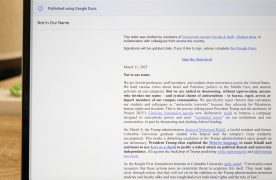Part two of a two-part series: BU coach Patrick Chambers convinces Patrick Hazel to leave Marquette for BU.
With the Marquette chapter of his career firmly behind him, it came time for Patrick Hazel to make the crucial decision of where to play next, where to fulfill the second chance that transferring granted him.
And from the start of the process, there was one school that stood out above the rest to the rising junior forward – Boston University.
Coming out of Blair Academy, Hazel had been pursued hard by then-BU and current University of North Carolina at Charlotte assistant Orlando Vandross before making the decision to sign with Marquette.
About a week after Hazel informed Williams of his intention to transfer, he was contacted by new BU head coach Pat Chambers, who had just completed a five-year stint as an assistant at Villanova University.
Having routinely scouted Marquette for coach Jay Wright and the Wildcats, Chambers knew of Hazel and was impressed with what he had seen, believing that Hazel’s style of play would help embody a new brand of BU basketball that placed a special emphasis on defense and rebounding.
“He was active, he made winning plays, he made a difference in the game, but most of all, he played hard,” Chambers said. “And anyone that Tom Crean thinks plays hard or Buzz Williams thinks plays hard, you know what, I’m probably going to agree with them that this kid’s got ability and some raw talent that we have to work with.”
The sense of familiarity Hazel found at BU, with its former Big East coach and fellow New York-area players like John Holland, all it took was a single visit for Hazel to make a decision. BU was where he wanted to be.
“This was a big decision that would change the rest of my life and I felt like I was most comfortable here,” Hazel said. “I didn’t even want to go on any other visits because I knew I wouldn’t feel as comfortable as I felt here. Just knowing those guys, it made a big difference.”
Upon getting to BU, however, Hazel was forced to sit out a year to comply with NCAA transfer rules. Again, there was another transition that Hazel had to work through, only this one would reduce him to the bench, an unappealing proposition for a guy who had been playing on a consistent, day-to-day basis for well over a decade.
But sitting out with two other transfers in junior guards Darryl Partin and Matt Griffin, Hazel did not view the year off as that – rather, he saw it as an opportunity to ease into his new environment and focus on improving his own game and understanding the game of basketball better as a whole.
“Anybody transferring, they can’t even lie and say it wasn’t tough,” Hazel said. “But I felt like that year made a difference for me, it helped me grow as a person too, not just a player, and it let me appreciate the game a lot more just to know that you don’t get many opportunities like this, to come to such a nice school with such good academics and a coach like Coach Chambers.
“Of course it sucked to sit out, but it wasn’t as bad as I thought it would be, and it could have been a lot worse. I was dying to play, I’ll tell you that.”
Once he fulfilled the NCAA requirement, it was time for Hazel to once again take the court for the 2010-11 season, this time with a retooled skill set and renewed appreciation for the game. Additionally, before he even suited up for the Terriers in a game, Chambers named Hazel as a team tri-captain, giving him added responsibility over an overhauled roster that featured seven freshmen and three transfers.
By the nature of sitting out a year, Hazel showed apparent signs of rust early on, averaging four points on just 44.6 percent shooting and 5.5 rebounds. But as the season progressed, Hazel’s game followed suit, as he stepped up his production to the tune of 6.2 points per game on 68.5 percent shooting and 6.9 rebounds per game in BU’s final 10 games.
A defensive stalwart on the low post throughout the season, Hazel’s 1.8 blocks per game led the team and ranked him second in the America East Conference. For his efforts, he was recognized as an AE first team all-defensive honoree.
But perhaps most importantly, as Hazel’s game was elevated, so was that of his BU team, as the Terriers rebounded from a 10-13 record in late January to reel off 11 straight wins en route to an AE tournament title and a berth in the NCAA Tournament.
Though he said he demands a lot more of himself as a player, Hazel managed to improve and redefine his game, all while securing a niche as a strong, reliable low-post presence on a team built around Chambers’ ideals of defense and rebounding. Even more than that, he’s emerged as a leader on a team that only had one senior last season.
With the difficulties and impediments that plagued Hazel early in his career now behind him, he insists that he was made better by those hindrances. In a sense, they allowed him to develop into the player and person that he is today.
“Marquette was a great experience and I learned a lot, but I wouldn’t change it,” Hazel said. “If Crean would have stayed, who knows, that’s just the land of ‘woulda, coulda,’ and I don’t want to live in that land. I’m glad everything happened, good and bad.”
But more than anything, Hazel’s story that continues to unfold at BU is one of forging a new path and making the best of a situation when plans don’t fully come to fruition.
While Hazel says that he learned from his time at Marquette and wouldn’t change a thing about how his career has played out, his experience as a transfer at BU has served as a reminder of what can happen when an athlete makes the most of a second chance and turns it into a shot at redemption.
“Not many people get opportunities like the one I got, to be able to come to Boston University and be around a coach like Coach Chambers who focuses on unity and family within the team and just progressing and getting better every day,” Hazel said. “I feel like this was a perfect fit, and I grew as a player and, more importantly, as a person.”
This is an account occasionally used by the Daily Free Press editors to post archived posts from previous iterations of the site or otherwise for special circumstance publications. See authorship info on the byline at the top of the page.












